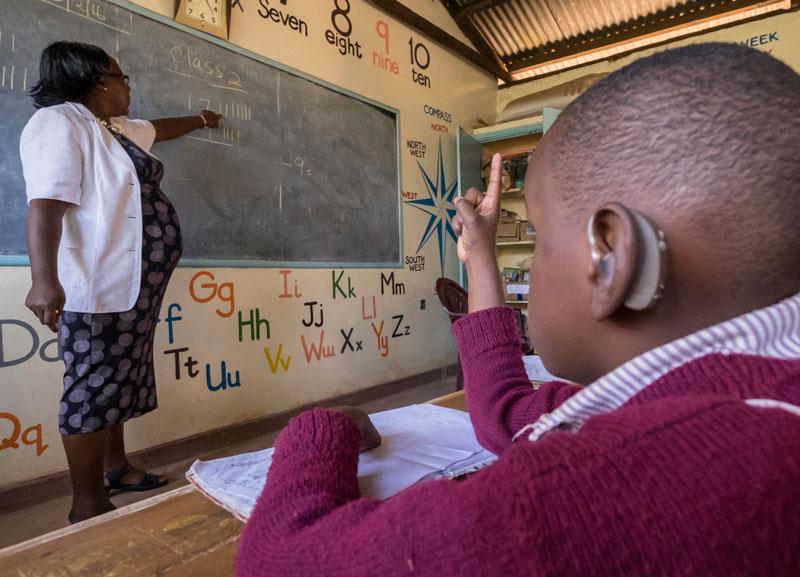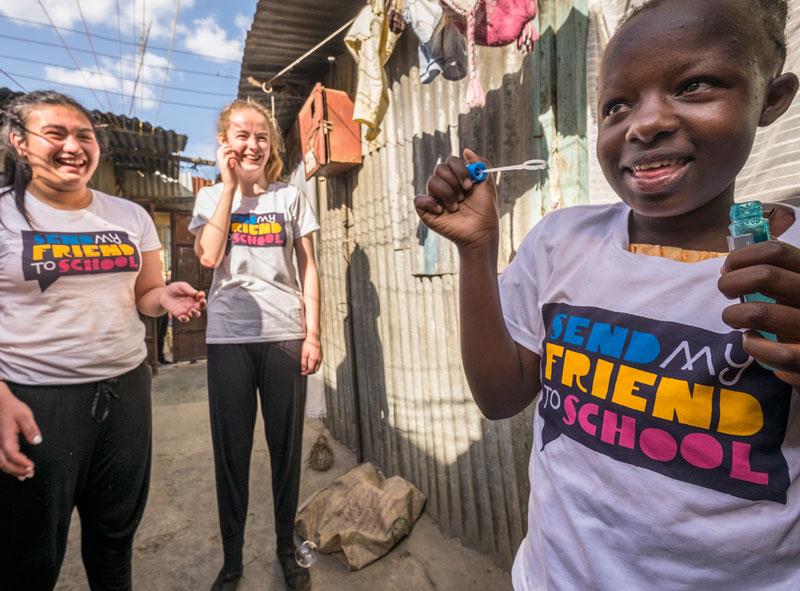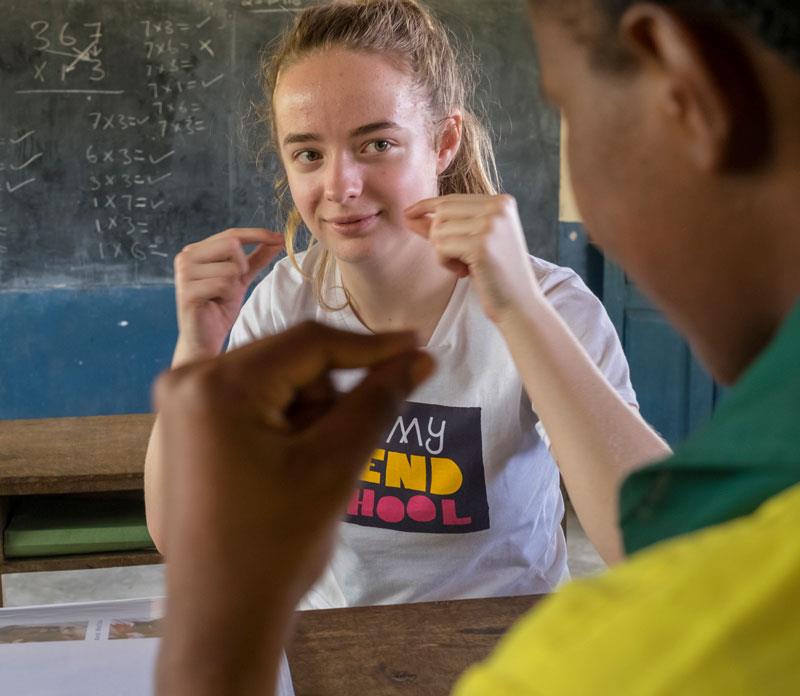
Jessica Hardy and Samina Begum – year 10 students from Limehurst School in Loughborough – are the 2016 Young Ambassadors for the Send My Friend to School campaign. They have just returned from Kenya with Deaf Child Worldwide where they investigated the barriers to education for deaf children.
Worldwide, 124 million children, aged five to 15, are missing out on school. Children with disabilities make up a large proportion of these, often finding it hard to access the education that is their right.
In Kenya, it is estimated that as few as one in six children with disabilities are in school. However, the new Global Goals agreed last year now include a focus on “inclusive and equitable education for all”.
This week, SecEd publishes a diary from their trip explaining the situation for some of the children they met and highlighting the task ahead for the Kenyan government and world leaders. It is all part of the on-going campaign to achieve universal education for every child.
Day 1: Arriving in Africa
Jessica: “I was amazed at how beautiful the country is ... it took a while for me to take everything in; the massive groups of people and the loudness of the capital city was almost overwhelming.”
Samina: “We went to meet Raynor, a passionate advocate for the right to education. Raynor represents Elimu Yetu Coalition (EYC), Kenya’s Global Campaign for Education. She explained that while basic education is free in Kenya because 50 per cent of people live below the poverty line, hidden costs like buying uniforms mean that 1.6 million children are still missing out on school.
“The EYC is doing many interesting things to improve education in Kenya, such as asking the government to get better at data – a lack of statistics means the government doesn’t know how to prioritise spending.”
Jessica: “Our final task today was to learn how to communicate effectively with deaf people from Richard Mativu, the Deaf Child Worldwide advisor, and prepare ourselves for the week ahead.”
Day 2: Visiting schools & homes in Nairobi
Samina: “The first school we visited was Baba Dogo Primary School, a mainstream school with a specialist deaf unit. Children there are up to 18-years-old because in Kenya, regardless of your age, you must pass classes 1 to 8 before moving onto secondary school.
“The headteacher Rosalyn told us that deaf children have to travel long distances to get to a school with specialist support. And here there are just 18 teachers for 1,500 pupils. The government should be sending money to support children with special educational needs, but she said they haven’t in a while.

A pupil with a hearing aid at Baba Dogo Primary School in Nairobi
“The little children in the colourful deaf unit were bursting with enthusiasm. Unfortunately, it wasn’t all sunshine; there were only two teachers, each teaching three different classes as the pupils varied in age and ability. Many children wish to attend this school but there’s not enough space or enough teachers.”
Jessica: “In a slum area of Nairobi we visited the Shadow Mountain Children’s Home. I had only seen poverty like this on a screen before, so it took a long time to understand it all.
“The home had 73 pupils living there – the majority were orphans – with just four teachers and a cook. It was upsetting to see how small it was and the conditions were poor. Surprisingly, all the students still wore a school uniform, showing how important education was to them.
“Next we attended a support group for parents of deaf children at Thawabu Primary School. I loved hearing from mothers, like Anne and Beatrice, about how this group has improved their lives. It made them happier and helped them learn Kenyan Sign Language (KSL) for free so they can communicate with their children. It was very sad to hear from the headteacher Mwangi that for some people “the deaf are seen as a curse, as a bad omen”.
“We went to visit the home of an out-of-school girl, called Fadhiri. Her mum and dad told us how she used to go to school, but now they can’t afford it. It was heartbreaking to find that Fadhiri doesn’t know sign language so it’s difficult for her to communicate with anyone.
“She hid behind her mother but towards the end of our visit Fadhiri seemed more confident and we had fun blowing bubbles with her outside. I could see that she was just as playful and intelligent as any other child.”

Samina and Jessica with Fadhiri in the Nairobi slum
Day 3: Learning more from politicians
Jessica: “We started early with a meeting at the Ministry of Education. They explained their vision for “an inclusive school system, which doesn’t discriminate”, but we were told that the biggest challenge is funding, resulting in a lack of assistive devices, such as hearing aids. This means many children can’t go to school, as without them they can’t learn.
“This meeting also reinforced that everyone has the right to go to school and it’s the government’s responsibility to provide a quality education for them.
“Finally, we had a meeting with the Kenyan Union of Teachers (KNUT) who told us that many teachers are training to teach children with disabilities but are unable to find jobs due to the lack of government funding to hire more teachers, resulting in the shocking pupil-to-teacher ratios.”
Day 4: Visiting a residential deaf school
Samina: “Off to rural Diani – red sand and greenery – a big contrast to industrialised Nairobi. And then to a project empowering communities to support deaf children, alongside Deaf Child Worldwide and VSO, to enrol in school and their families to attend free sign language classes.”
Samina: “As soon as we got to Kwale Residential School we could smell burning. The headteacher told us that the smoke is constantly polluting the school because farm owners were setting hundreds of trees on fire to clear their land.
“One of the students, Jawa, told us how everyday he and his classmates take it in turns to rush down to the fire, grab as much wood as they can to put it out and then rush back to make sure they are not falling behind in their lessons.
“They are literally risking their lives for their education. My eyes started to get red and sore from all the smoke, but some of these students have been tolerating this for years because there is no other school nearby where they can get the education they need.
“Why are these children suffering as a result of having a disability? I am still so furious thinking about it. But for them, we will be their voice. We will do our best to make sure these pupils are in a safe learning environment because absolutely nobody in this world should have to put their lives at risk, just so they can get an education.”
Day 5: Kinanga School for the Deaf
Jessica: “Our last day and Kinanga School for the Deaf. I remember thinking how quiet the school was, but when we entered the classrooms we realised a lot of conversation was going on, just that it was in sign language. My favourite part was having a conversation with a smiley girl called Salome. I introduced myself in sign language and I’m happy that she was patient as I probably made a few mistakes! She told me that she wants to become a hairdresser in the future and she loves school.

Jessica talks to Salome using Kenyan Sign Language at Kinanga School for the Deaf
“We sat in one of the dormitories and I found that up to three girls can share one bed and some have no mattresses. I can’t imagine how uncomfortable it would be to live like that.”
Samina: “I met Anzazi, a girl my age, who told me she brought herself to this boarding school to get an education because her parents believed she wasn’t worthy of one. Her parents don’t provide anything for her and won’t even come to visit her. Can you imagine how it must feel that your parents don’t want you because you’re deaf?
“But she made me smile telling me she wants to be a role-model for children in the same situation. She wants them to realise that they still deserve to be respected and well-educated. I gave her a Send My Friend to School t-shirt and told her when she wears it to remember that I will always be her friend. This campaign is all about sending our friends to school and getting them an education, in a safe environment, regardless of whether they have a disability or not.”
Day 6: Back in the UK
Jessica: “This week has really opened my eyes to the education system in another country. It felt amazing talking to so many people about the Send My Friend to School campaign, and to see how much hope we gave them. I am so proud to be a part of this campaign and I know that we can continue to work hard and make a difference.”
Samina: “It has been a pleasure working alongside Deaf Child Worldwide and I will treasure this memory for the rest of my life. Now that our trip is over, I can only hope to make all the people I’ve met this week proud by lobbying for this issue so that we can ultimately send all our friends to school.”
The Global Campaign for Education
In 2000, governments around the world pledged to achieve universal primary education by 2015 – a target that was missed, despite much progress being made.
There are still 57 million primary children around the world who are not in education, with more than half of these living in sub-Saharan Africa. Half also live in conflict zones.
World leaders set a new series of Sustainable Development Goals last year, including a pledge to achieve universal primary and secondary education by 2030. Worldwide there are currently 124 million children up to the age of 15 out of school.
The Global Campaign for Education is seeking to hold these governments to account for this promise and the UK Send My Friend to School campaign offers resources and support to help young people hold politicians and government to account.
You can join Jessica and Samina on the Send My Friend to School campaign and sign up for a free schools pack at www.sendmyfriend.org
